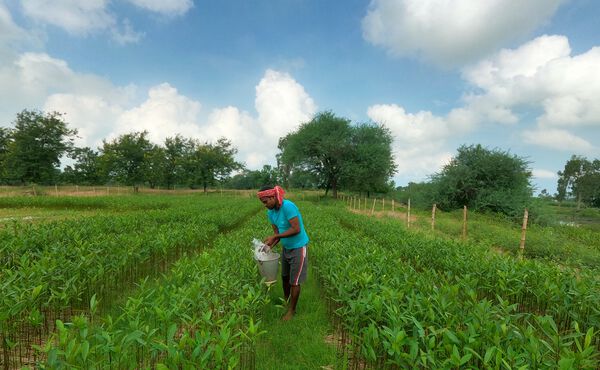Mangroves are vital, but don’t just take it from us – we spoke to the locals of the Sundarbans about why they need their forests restoring
This year, we’ve been working with leading environmental organisations to plant, protect or restore a tree for every refill you’ve bought. Why? One thing is for sure: the world needs more trees. From enriching our soil, to removing carbon from the atmosphere, you probably already know how much good they do for our planet. What you might not know, is how important these tree-growing projects are to some communities around the world. One of our focus projects this year has been restoring the Sundarbans, a mangrove forest near the Bay of Bengal in India. We spoke to community members there about how the projects have helped shape the area's future and the lives of the locals.
Varun and Subola Mondal
This is the Mondal family. Varun and Subola live with their two young children in a tin hut on stilts, right by a river in the Sundarbans. Mangrove trees used to cover the shorelines of this river, providing a physical barrier to the local communities against storms and flooding. Sadly, in recent years, these natural disasters have become more frequent. “The climate has become harsher and more unpredictable,” explains Subola, and their village has suffered the effects. One study found that 24.5% of these forests have disappeared in the past three decades and this strong buffer, that used to protect the locals, now has gaps for the wind and water to travel through, hitting the local villages.
.jpg?sw=600&sh=370&sm=fit&cx=0&cy=0&cw=730&ch=450&sfrm=jpg)
In 2020, super cyclonic Storm Amphan caused widespread damage in Eastern India. “It was a difficult time,” recalls Varun. “I still remember the high tide ended at noon, but strangely instead of low tide, the water level was rising even after high tide. Then the flood came. Our boat swept away. I tried hard but I couldn’t save the boat.” During the storm, the water levels rose through the floor of their bamboo hut. Varun and his wife kept their children on the bed, while they held onto it, so they wouldn’t drown. “As water entered our home, we moved to my relative's house which was in a highland area. For 5-6 days we stayed there and after we returned to our home, there was hardly anything. Everything was swept away by the flood.”
It’s devastating when this happens once, but heavy storms and flooding happen 2-3 times every year. And, beyond the community, these disasters also have lasting effects on the landscape. “The flooding causes erosion and the river is expanding on this side,” explains Subola. “Now during each full moon, tide water enters our room. Sometimes snakes also come into our house during the full tide. I don’t know how long we will be able to survive here.” The project here is working to plant, protect and restore those very vital mangrove forests and while it will take years for the forests to grow back to their full barrier, it has given the locals hope. Both Varun and Subola have been involved in the project, planting saplings in the nurseries. “The best thing about working on the project, is that I know one day the saplings I grow in the nursery will create dense forests and protect us from harsh natural calamities.”
Before working in the nursery, Varun’s main source of income was fishing. Every day he would wake at the start of high tide (usually around 2-5am) and would sometimes spend the whole night on his boat, tending to the floating nets that catch fish during the high tide. Sometimes he would travel far south to the rivers near the islands Bakkhali and Mohsuni, and even north on his one-cylinder boat. Aware of the risks northbound of rolling waves and powerful winds, he was fuelled by the need to provide for his family to go out further in search for fish. “It’s definitely scary,” says Varun, “but that is our only way to earn some good income whenever possible. There are much more fish in the sea than there are in the river, thus I felt the risk was worth taking.” Since working on the project, Varun no longer has to fish for such long and dangerous hours. “Now I don’t need to go every day, instead I work in the nursery most of the time,” explains Varun. “I can spend more time with my family,” adds Subola, “as the nursery is just behind my home, I can also take care of children whilst working.” They are both hopeful that their children will have access to the bounties of the mangroves and a thriving community of people who work with nature.
Click here to shop our wide range of handy refills.
.jpg?sw=600&sh=370&sm=fit&cx=0&cy=0&cw=730&ch=450&sfrm=jpg)
Anil Mistry
Ex-poacher turned conservationist, Anil Mistry is now the go-to man on the island for guidance on this project and the protection of both the locals and animals. Having lived on different islands in the Sundarbans throughout his life, he knows the landscape like the back of his hand. But protecting these forests was not always forefront on Anil’s mind. Many years ago, he used to be involved in doing the opposite by both chopping down trees and poaching tigers. “I got into poaching because it was adventurous, and we used to hunt deer for its meat,” recalls Anil. “I did know it was wrong, but poaching was common in my neighbourhood at that time and there was not much awareness or restrictions.” However, Anil’s involvement in poaching came to an abrupt halt when he witnessed a scene that made him rethink his actions. “A horrible incident changed my mind one day when I saw a baby deer killed in front of the mother deer by fellow poachers.” From then, he stopped completely and instead began patrolling and protecting the forests.
.jpg?sw=600&sh=370&sm=fit&cx=0&cy=0&cw=730&ch=450&sfrm=jpg)
Despite the danger of coming close to tigers and having himself been involved in an attack, Anil has become a key player in protecting the tigers of the Sundarbans. The Sundarbans is a UNESCO heritage site and is considered a delicate and complex ecosystem where biodiversity is key. The endangered Bengal tigers are vital to the forest. At the top of the food chain, they control the population of herbivores which rely on the trees and plants for food. They are the forests’ protectors. Because these forests are so close by to villages, it’s not uncommon for the tigers to wander in. Unsurprisingly, this causes panic, and in the past tigers would become injured or even killed as the villagers fought to protect themselves. Conservationists like Anil have worked hard to create awareness of their importance, and methods of protecting them. “A major change has happened in the relationship between animals and people. Earlier people used to think that the tiger is their enemy, now people realise that the forest is their source of livelihood and the tigers protect the forest.”
On an average day working on the project, Anil goes on patrols, meets the forest officers, monitors mangrove plantation sites, speaks with villagers and organises awareness campaigns. He is extremely passionate about saving the mangrove forests in this area. “If we can't protect the embankment, then it will be very hard for people to live in the Sundarbans.”
We recognise the importance of supporting these projects to protect embankments, forests and local communities. And you can help. Every refill you buy, we will continue to plant, protect or restore a tree, either in the Sundarbans or in one of our other projects across the world.






